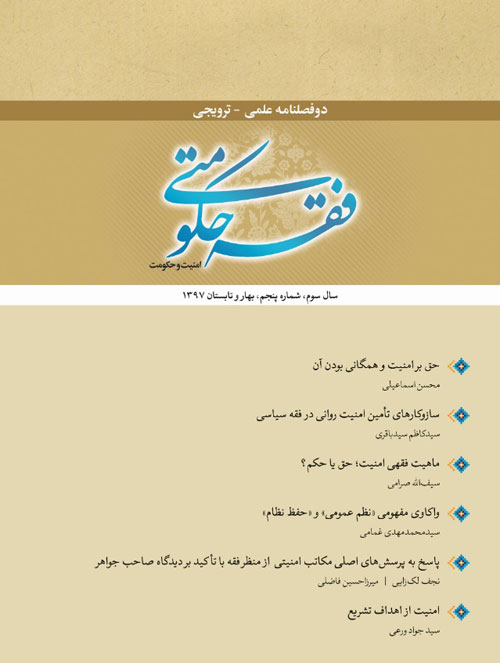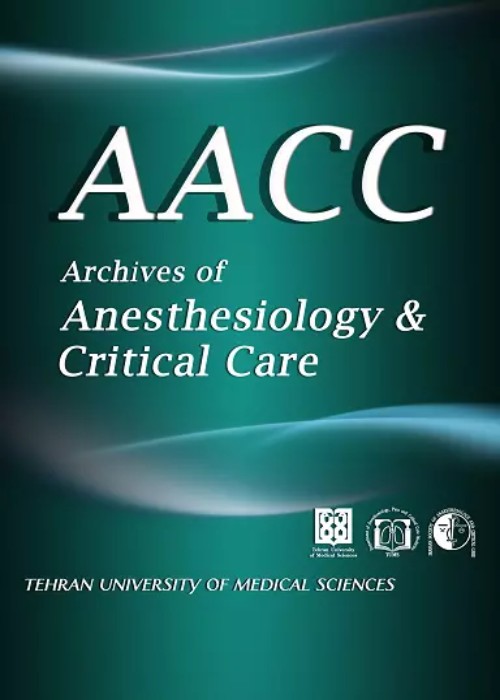فهرست مطالب

Archives of Anesthesiology and Critical Care
Volume:5 Issue: 2, Spring 2019
- تاریخ انتشار: 1398/01/18
- تعداد عناوین: 10
-
-
Pages 32-34BackgroundAnemia is a common disease in older patients and prevalence of anemia increases with high age. Preoperative anemia is associated with high mortality after surgery. The severity of anemia is variable and is affected by blood loss volume, pre-operative hemoglobin (Hb) value and transfusion during surgery. However, the strategies of blood management for optimization of Hb before surgery are more important. Therefore, surgery and anesthesia teams always follow these issues: how we can decrease intraoperative blood loss and complications of bleeding and transfusion? However, the aim of study was comparison of Hb in pre- and post- operative period in older patients undergoing major orthopedic operation.MethodsA descriptive cross-sectional study was conducted on 230 patients aged more than 65 years who underwent orthopedic surgery from 2016 through 2017. Hb value was measured after and before surgery and compared.ResultsThe mean age of participants was 75.8. 54.3% of cases were female. Most of the patients (70.4%) had concurrent disease such as hypertension, diabetes mellitus and heart disease. The most common types of surgery were as follows: DHS, total replacement of knee and hip bipolar hemiarthroplasty. The mean difference value of Hb in pre and post– operative period was significant and was reduced from 12.6 to 10.3g/dL.ConclusionThe mean difference value of Hb in pre and post– operative period was significant. However, orthopedic surgeries can reduce Hb in older patients. In regard to older subjects being considered as high-risk group, routine control and proper correction of Hb in such operations is necessary.Keywords: Older subjects, Anemia, Orthopedic surgery, Hemoglobin
-
Pages 35-37BackgroundCurrently, the administration of non-opioid analgesics as a preemptive treatment has been approved by the surgeons of jaw due to lack of side effects of opioids in jaw surgery. However, which medicine as a pre-medication has a good result, is a controversy. Therefore, the aim of this study was to investigate the effect of preemptive therapy by pre-gabalin single dose on opioid consumption rate after surgery on mandibular fractures.MethodsThis double-blind clinical trial was conducted in Tabriz Imam Hospital in 2012 on 60 patients who were undergoing mandibular fracture surgery. Patients were classified as intervention and control groups and the intervention group consumed one pregabalin capsule 300 milligrams with 50 ml of water half an hour before surgery. The amount of opioid use in the first eight hours after surgery was measured and recorded in both groups.ResultsOpioid use in both groups was decreased with time- spending. There was also a significant relationship between opioid use in both intervention and control groups (P <0.001).ConclusionPregabalin premedication could have analgesic effects in lower jaw fracture surgery and decrease opioid use after surgery.Keywords: Pregabalin, Preemptive, Mandible, Fracture, Opioid
-
Pages 38-40BackgroundShivering refers to a series of repetitive involuntary movements of the skeletal muscles commonly occurring during spinal anesthesia. Regional anesthesia (both spinal and Epidural) reduces vasoconstriction and shivering threshold to 6 degrees Celsius above the surface of the block. The aim of this study was to determine the effect of prophylactic administration of intravenous paracetamol in controlling shivering during and after cesarean section under spinal anesthesia.MethodsIn a double-blind randomized clinical trial in the Department of Anesthesiology of Tabriz on patients undergoing cesarean section with spinal anesthesia, the effect of prophylactic administration of paracetamol IV in controlling shivering during and after cesarean section under spinal anesthesia was evaluated.ResultsThe mean gestational age of patients was 37.94±1.07 weeks in paracetamol group and 37.58±2.07 weeks in the control group (p=0.278). The mean shivering scores of patients in paracetamol group were 0.72±0.80 in the operating room and 1.32±1.05 in recovery room (P<0.001). The mean shivering scores of patients in control group were 1.16±1.07 in the operating room and 2.28±1.45 in recovery room (P<0.001). The mean increase of shivering score in patients was 0.60±0.98 in paracetamol group and 1.12±1.46 in the control group. The mean increase of shivering score in patients in paracetamol group was significantly less than the control group (p=0.041).ConclusionIn the present study, the prophylactic use of intravenous acetaminophen reduced the rate of increase of shivering in patients after spinal anesthesia. Postoperative complications in patients in paracetamol group was less than the control group, however, this difference was not statistically significant.Keywords: Shivering, Paracetamol, Spinal anesthesia, Cesarean section
-
Pages 41-44BackgroundAnxiety, in demanding situations such as the perioperative period, can exacerbate underlying diseases and lead to a variety of perioperative complications. Educating patients not only improves the level of knowledge but can also help patients coping skills. The aim of the present study is to determine the effect of face-to-face plus printed educational materials on the anxiety level of Iranian pregnant women undergoing elective cesarean section delivery in the perioperative period.MethodsSTAI questionnaire was distributed to 50 pregnant women undergoing cesarean section on the day before operation, then the intervention group was educated face to face for one session followed by the pamphlet. After training, the STAI questionnaire was again distributed to the intervention group on the same day. For evaluating the level of anxiety, we also used the Visual Analog Scale (VAS). The presence of nausea/vomiting after surgery and the type of anesthesia technique were recorded.ResultsBasic characteristics of the parturient regarding age, education level and the baseline level of anxiety were similar.
In the intervention group, the average anxiety level with STAI(S) questionnaire was 48.1 before the education and 45.2 after face to face outreach (P = 0.019).
The average anxiety level with VAS score was 5.6 before the education and 4.8 after the outreach in the interventional group (P = 0.018). STAI(S) and VAS scores in the control group were 43.3 and 5.1 respectively which increased to 44.2 and 5.7 in the second survey.
The correlation coefficient between score in the STAI questionnaire and VAS was 0.479.ConclusionA single period of face to face education followed by handing out a pamphlet before an operation reduces the anxiety of mothers before cesarean section delivery.Keywords: Anxiety, Cesarean section delivery, Education -
Pages 45-48BackgroundPostoperative nausea and vomiting (PONV) leads to an increase in intraocular pressure (IOP) and its side effects, which should be controlled using the least complicated method. Therefore, the purpose of this study was to evaluate the effect of 80% supplemental perioperative oxygen on PONV in patients undergoing cataract surgery.MethodsThe present double-blind clinical trial was conducted on 201 patients undergoing cataract surgery. The subjects were selected by convenience sampling method and randomly divided into two groups of oxygen 30% administration and oxygen 80% administration. The operation of patients was performed with the same surgical procedure and team. After the operation, the incidence rate of PONV was recorded in both groups and compared along with other variables by SPSS software using descriptive statistics and chi-square.ResultsThere was no significant difference in age and sex between the two groups. The incidence rate of PONV was high in both groups, with statistically significant higher value in the group with 30% supplemental oxygen compared to the group with 80% supplemental oxygen (p=0.000).ConclusionThe use of 80% perioperative oxygen concentration could reduce the PONV severity.Keywords: Postoperative nausea, vomiting, Cataract surgery, 80% oxygen concentr
-
Pages 49-53BackgroundThe purpose of this study was the evaluation of diazepam administration on perioperative blood pressure in hypertensive patients who undergoing cataract surgery.MethodsEighty controlled hypertensive patients who underwent cataract surgery under topical anesthesia and conscious sedation were enrolled in this study. All patients were randomly divided to two equal size group for administration of diazepam 0.05 mg/kg (n=40, diazepam group) and midazolam 0.01 mg/kg (n=40, midazolam group) in order to conscious sedation. The systolic and diastolic blood pressure, heart rate and oxygen saturation were recorded preoperatively as baseline value, and then 5, 10 and 15 minutes after diazepam or midazolam administration.ResultsThere were no difference between two groups in terms of systolic, diastolic and heart rate preoperatively. Systolic and diastolic blood pressure was decreased significantly more in diazepam group compared to midazolam group perioperatively. Heart rate did not change significantly in both groups. Oxygen saturation of blood was decreased in both groups but not statistically significant. Systolic and diastolic blood pressure variability during each period intraoperatively was lower in diazepam group compared to another group. Systolic and diastolic blood pressure of patients during recovery room in diazepam group was lower than midazolam group.ConclusionIn hypertensive patients who undergoing cataract surgery with topical anesthesia, administration of diazepam in order to conscious sedation is an effective and safe method with less perioperatively side effects.Keywords: Diazepam, Midazolam, Cataract surgery, Hypertensive patients, Heart rate
-
Pages 54-61Venous air embolism (VAE) is an entrapment of air or exogenously delivered gas from the operative field or the communicated environment into the venous system due to gradient pressure. VAE and paradoxical air embolism (PAE) are potentially serious neurosurgical complications and carry high neurologic, respiratory, and cardiovascular morbidity or even may be fatal. Some procedures are at risk of developing these conditions, but the sitting and semi-sitting positions represent a higher risk. It’s occurrence during anesthesia is challenging to the anesthesiologists in terms of early discovery and management. Anesthesiologist can play an important role in detection and urgent treatment of VAE in case of occurrence. If the sitting position is needed for a neurosurgical necessity it can be used with vigilant follow up throughout the procedure to detect any occurrence of VAE.Keywords: Vascular air embolism, Venous air embolism, Paradoxical air embolism, Sitting position, Neuroanesthesia
-
Pages 62-68Spinal cord injury (SCI) occurs due to any damage to the spinal cord and cauda equina. Most of the patients after spinal cord injury develop chronic pain, irrespective to the site and type of pain. This pain is severe in most of the cases and severely impairs the quality of life. The mechanisms responsible for the pain after spinal cord injury is poorly understood. The pain of SCI is basically classified in two main types: nociceptive or neuropathic. The objectives of this paper are to review the different treatment options for the SCI pain. The pain management after SCI includes pharmacological therapy and non-pharmacological therapy.Keywords: Spinal cord injury, Pain mechanism, Pain management
-
Pages 69-70Thalassemia is an inherited defect in the production of globulin chains transmitted by autosomal recessive inheritance. Anaesthetic management of these patients is challenging, being associated with hypersplenism, unanticipated difficult airway and vertebral malformations, perioperative high blood pressure, systemic features of iron overload, cardiac and hepatic failure and anaemia. In this case, we highlight the anaesthetic concerns in a child of beta thalassemia intermedia with high levels of Hemoglobin F posted for splenectomy along with cholecystectomy. To avoid need of postoperative mechanical ventilation due to low oxygen carrying capacity of blood and anaerobic metabolism during the period of surgical stress, epidural catheter inserted despite possibility of epidural hematoma or bleed because of thrombocytopenia. Patient had an enhanced recovery in term of decrease oxygen demand, decrease postoperative nausea and vomiting, early ambulation and patient satisfaction. Intraoperative epidural also decreases need of neuromuscular blocking agent and intravenous analgesia. This lead to faster awakening from anaesthesia even in the presence of decrease oxygen carrying capacity due to anaemia and acidosis (anaerobic metabolism). Use of regional anesthesia should be considered in similar cases after assessing risk and benefits for individual cases.Keywords: Thalassemia intermedia, Epidural anesthesia, Thrombocytopenia, Enhanced recovery
-
Pages 71-72Accidental finding of yellow colored CSF may pose a sudden dilemma to the mind of anesthesiologist whether to perform the block or not. Yellow coloration of CSF can be due to subarachnoid bleed or raised protein in the CSF. Anesthesiologists should have a working knowledge of this subject which will help in managing the cases peri-operatively with improved outcome.Keywords: Xanthochromia, Nonne-Froin sign, Subarachnoid block


